Source: Galaxy; Compiled by: Deng Tong, Golden Finance
Foreword
2024 saw a dramatic shift for Bitcoin and digital assets. 2024 saw new products, record inflows, huge policy shifts, growing popularity, and the consolidation of Bitcoin as an institutional asset.
This year saw two major developments: the launch of spot-based Bitcoin ETPs in the U.S., and the election of Donald Trump to a second non-consecutive presidential term. Between these events, the market spent 237 days in a volatile, indecisive sideways consolidation. While these events were both catalyst and backdrop for the 2024 market, 2025 will see a broadening of market breadth and narrative. Without further ado, here are some Galaxy Research predictions for 2025.
Bitcoin
Bitcoin will surpass $150,000 in the first half of the year and test or reach a maximum of $185,000 in the fourth quarter of 2025. A combination of institutional, corporate, and country adoption will drive Bitcoin to new heights in 2025. Since its existence, Bitcoin has appreciated faster than all other asset classes, especially the S&P 500 and gold, and this trend will continue in 2025. Bitcoin will also reach a market value of 20% of gold. By 2025, the total assets of US spot Bitcoin ETPs will exceed US$250 billion. In 2024, Bitcoin ETPs attracted a total of more than $36 billion in net inflows, making it the largest ETP in history. 13F filings show that many of the world's major hedge funds have purchased Bitcoin exchange-traded products, including Millennium, Tudor, and D.E. Shaw, while the Wisconsin Investment Board (SWIB) has also purchased Bitcoin exchange-traded products. Just one year later, the asset size of Bitcoin exchange-traded products (ETFs) is only 19% ($24 billion) away from the asset size of all physical gold exchange-traded products in the United States.
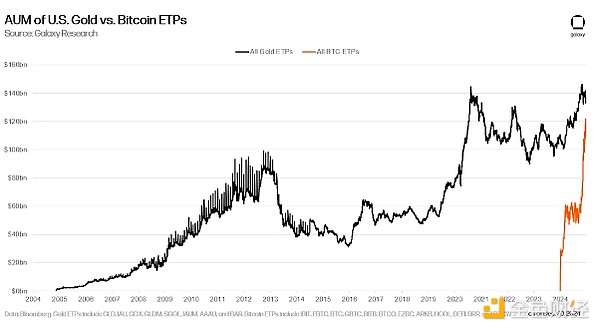
By 2025, Bitcoin will once again be one of the best risk-adjusted performing assets among global assets. The above AUM comparison is due to record inflows and Bitcoin price increases in 2024. In fact, Bitcoin is the third best performing asset on a risk-adjusted basis. Notably, the best Sharpe ratio belongs to MicroStrategy — a company that calls itself “the Bitcoin Finance Company.”
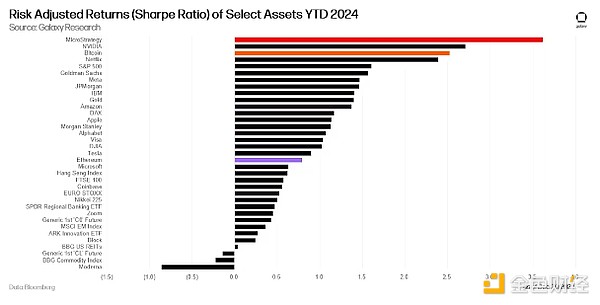
At least one of the top wealth management platforms will announce a recommended 2% or higher Bitcoin allocation. For a variety of reasons, including maturity, internal education, compliance requirements, etc., no major wealth management firm or asset management company has officially added Bitcoin allocation recommendations to investment advice model portfolios. This situation will change in 2025, which will further increase the flow of US dollars and the scale of assets under management.
Five Nasdaq 100 companies and five countries will announce that they have added Bitcoin to their balance sheets or sovereign wealth funds. Whether for strategic, portfolio diversification, or trade settlement reasons, Bitcoin will begin to find a place on the balance sheets of major corporate and sovereign allocators. Competition between nation-states, especially non-aligned ones, those with large sovereign wealth funds, and even those hostile to the United States, will drive the adoption of strategies to mine or otherwise acquire Bitcoin. Bitcoin developers will reach consensus on the next protocol upgrade in 2025. Since 2020, Bitcoin Core developers have been arguing about which operations can safely enhance transaction programmability. As of December 2024, the two most supported pending operations for transaction programmability include OP_CTV (BIP 119) and OP_CAT (BIP 347). Reaching consensus on soft forks has been a time-consuming and rare feat since Bitcoin’s inception, and including OP_CTV, OP_CSFS, and/or OP_CAT in the next soft fork upgrade -Gabe Parker.
More than half of the top 20 publicly traded Bitcoin miners by market cap will announce transformations to or partnerships with hyperscalers, AI, or HPC companies. The growing demand for AI computing will cause Bitcoin miners to increasingly retrofit, build, or co-locate HPC infrastructure with Bitcoin mining farms. This will limit year-over-year hash rate growth, which will reach 1.1 zetahash by the end of 2025.
Bitcoin DeFi (considered the total amount of BTC locked in DeFi smart contracts and deposited in staking protocols) will nearly double by 2025. As of December 2024, over $11 billion worth of wrapped BTC is locked in DeFi smart contracts. Notably, over 70% of locked BTC is used as collateral in lending protocols. Roughly $4.2 billion in additional deposits are through Bitcoin’s largest staking protocol, Babylon. The Bitcoin DeFi market is currently valued at $15.4 billion and is expected to expand significantly by 2025 across multiple sectors, including existing DeFi protocols on Ethereum L1/L2, new DeFi protocols on Bitcoin L2, and staking layers like Babylon. The current doubling of the market size is likely driven by several key growth factors: cbBTC supply growth of 150% year-on-year, WBTC supply growth of 30%, Babylon's TVL reaching $8 billion, and the new Bitcoin L2 achieving $4 billion DeFi TVL. Ethereum will be traded at more than $5,500 by 2025. The easing of regulatory resistance to DeFi and staking will drive Ethereum to new all-time highs in 2025. New partnerships between DeFi and TradFi, perhaps in a new regulatory sandbox environment, will finally allow traditional capital markets to seriously experiment with public blockchains, with Ethereum and its ecosystem seeing the largest share of usage. Enterprises will increasingly experiment with their own layer 2 networks, primarily based on Ethereum technology. Some games leveraging public blockchains will find product-market fit, and NFT trading volumes will rebound significantly.
The Ethereum staking rate will exceed 50%. The Trump administration is likely to provide clearer regulation and guidance to the crypto industry. Demand for staking will continue to rise next year and could exceed half of Ethereum's circulating supply by the end of 2025, prompting Ethereum developers to more seriously consider changes to the network's monetary policy. More importantly, the increase in staking will drive greater demand and value flowing through Ethereum staking pools like Lido and Coinbase, and restaking protocols like EigenLayer and Symbiotic.
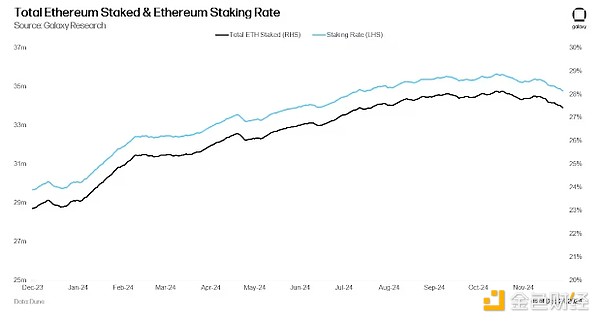
The ETH/BTC ratio, one of the most watched pairs in all of crypto, has been on a dangerous downward trend since Ethereum’s “merged” upgrade to proof-of-stake in September 2022. However, the expected regulatory shift will help Ethereum and its application layer, especially DeFi, reignite investor interest in the world’s second-largest blockchain network by value.
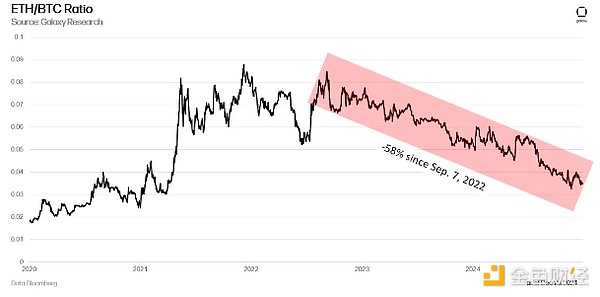
By 2025, L2 as a whole will generate more economic activity than Alt L1. L2 fees as a percentage of Alt L1 fees (currently in the mid-single digits) will exceed 25% of total Alt L1 fees by the end of the year. L2 will approach scaling limits early this year, resulting in frequent spikes in transaction fees, which will require changes to gas limits and blob market parameters. However, other technical solutions (e.g., Reth clients or altVMs like Arbitrum Stylus) will provide greater efficiency for rollups to keep transaction costs at usable levels.
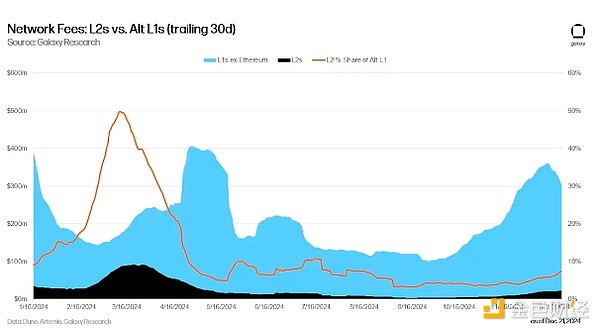
Decentralized Finance (DeFi)
DeFi will enter the "dividend era" as on-chain applications will distribute at least $1 billion to users and token holders through treasury funds and revenue sharing.As DeFi regulation becomes clearer, the value sharing of on-chain applications will expand. Applications such as Ethena and Aave have already initiated discussions or passed proposals to implement their fee switches, the infrastructure for distributing value to users. Other protocols that previously rejected such mechanisms, including Uniswap and Lido, may reconsider their stance in light of regulatory clarity and competitive dynamics. The combination of a relaxed regulatory environment and increased on-chain activity suggests that protocols may engage in buybacks and direct revenue sharing at a higher rate than previously observed.
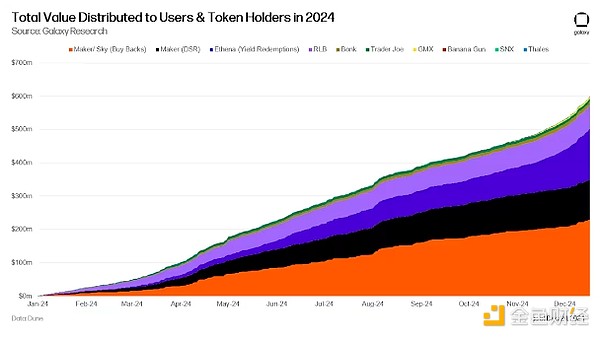
On-chain governance will resurface, and applications will experiment with future governance models. The total number of active voters will increase by at least 20%. On-chain governance has historically faced two issues: 1) lack of participation, and 2) lack of voting diversity, with most proposals passing by overwhelming margins. However, the easing of regulatory tensions has been a limiting factor for on-chain voting, and the recent success of Polymarket suggests both of these points will improve in 2025. By 2025, applications will begin to move from traditional governance models to future governance models, with improved voting diversity and regulatory tailwinds boosting governance participation.
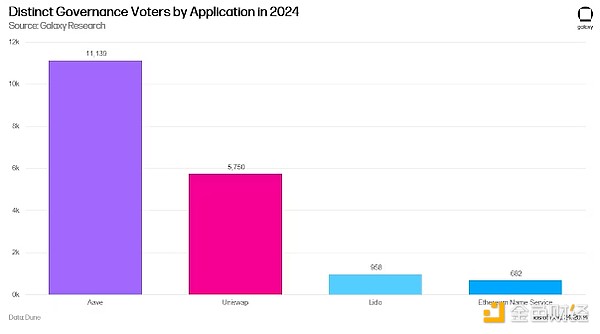
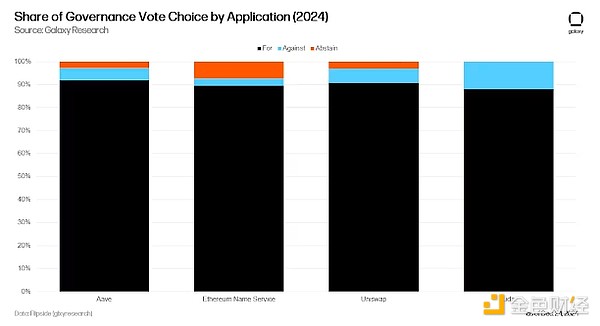
Banks and stablecoins
The Office of the Comptroller of the Currency (OCC) will create a pathway for banks in various countries to custody digital assets, guiding the world's four largest custodian banks to provide digital asset services: Bank of New York, State Street, JPMorgan Chase and Citigroup.
TradFi partners will support the launch of at least 10 stablecoins. From 2021 to 2024, stablecoins have experienced rapid growth, and the number of projects has now reached 202, including several projects closely related to traditional finance (TradFi). In addition to the number of stablecoins launched, its transaction volume growth has also exceeded that of major payment networks such as ACH (about 1%) and Visa (about 7%). In 2024, stablecoins will be increasingly integrated into the global financial system. For example, FV Bank, which has obtained a license in the United States, now supports direct stablecoin deposits, while Japan's three major banks are working with SWIFT through Project Pax to enable faster and more cost-effective cross-border funds flows. Payment platforms are also building stablecoin infrastructure. For example, PayPal launched its own stablecoin PYUSD on the Solana blockchain, while Stripe acquired Bridge to natively support stablecoins. In addition, asset managers such as VanEck and BlackRock are working with stablecoin projects to establish a foothold in the field. Looking ahead, as regulation becomes clearer, TradFi players are expected to integrate stablecoins into their operations to stay ahead of the trend, while first movers are ready to gain advantages by building infrastructure for future business development.
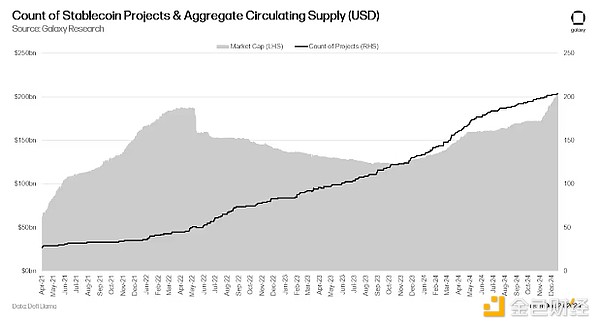
By 2025, the total supply of stablecoins will double to more than $400 billion. Stablecoins are increasingly finding product markets suitable for payments, remittances, and settlements. Increasing regulatory clarity on existing stablecoin issuers as well as traditional banks, trusts, and depository institutions will lead to an explosive growth in stablecoin supply in 2025.
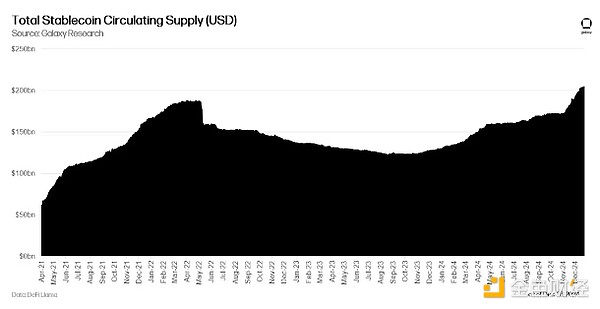
Tether’s long-term market dominance will fall below 50%, challenged by yield alternatives such as Blackrock’s BUIDL, Ethena’s USDe, and even Coinbase/Circle’s USDC Rewards. As Tether internalizes yield income from its USDT reserves to fund portfolio investments, marketing spend by stablecoin issuers/protocols to pass on revenue will shift existing users away from Tether and toward new users toward their yield solutions. USDC rewards for users' Coinbase exchange and wallet balances will become a powerful hook that will drive the development of the entire DeFi field and may be integrated by fintech companies to enable new business models. In response, Tether will begin to pass on the income from collateral holdings to USDT holders, and may even provide new competitive yield products such as Delta Neutral Stablecoins.
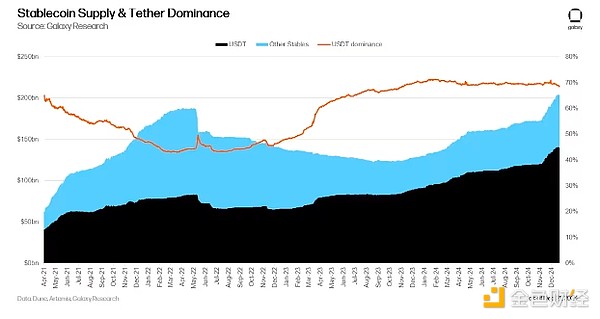
Investment and Policy
Total cryptocurrency venture capital investment will exceed US$150 billion, an increase of more than 50% year-on-year. The surge in VC activity will be driven by increased appetite among allocators for risky activities, given falling interest rates and increased regulatory clarity around cryptocurrencies. Cryptocurrency VC funding has historically lagged broader crypto market trends, and there will be some degree of “catch-up” over the next four quarters.
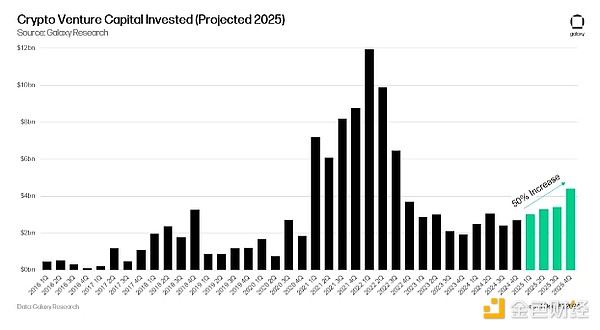
Stablecoin legislation will pass both houses of Congress and be signed by President Trump in 2025, but market structure legislation will not. Legislation formalizing and establishing a registration and oversight regime for U.S. stablecoin issuers will be passed with bipartisan support and signed into law by year’s end, which, combined with the expected easing of restrictions on banks, trusts, and depository institutions, will lead to significant growth in stablecoin adoption. Market structure—creating registration, disclosure, and oversight requirements for token issuers and exchanges, or adapting existing SEC and CFTC rules to incorporate them—is more complex and will not be completed, passed, and signed into law by 2025.
The U.S. government will not purchase Bitcoin in 2025, but will create a stockpile using Bitcoin it already holds, and there will be some action within departments and agencies to review expanded Bitcoin reserve policies.
The SEC will launch an investigation into the first so-called “special purpose broker-dealer,” Prometheum. A previously unknown broker-dealer has popped up that happens to align with the SEC’s overall view. Gensler Chairman’s views on the securities status of digital assets have attracted attention in 2023, especially when the unknown company received the first broker-dealer license in a new category. The CEO was reprimanded in Congress by Republican members of the House Financial Services Committee, according to FINRA records. Republicans called on the Department of Justice and the SEC to investigate Prometheum’s “ties to China,” while others pointed to irregularities in its fundraising and reporting. Whether Prometheum is investigated or not, the special purpose broker-dealer license will most likely be revoked in 2025.
Dogecoin will eventually reach $1, and the world’s largest and oldest meme coin will reach a market cap of $100 billion. However, Dogecoin’s market cap will be overshadowed by the Department of Government Efficiency, which will determine and successfully implement cuts in amounts that exceed Dogecoin’s 2025 high-water mark market cap.
 Kikyo
Kikyo


















